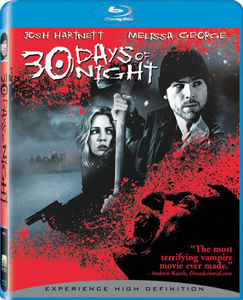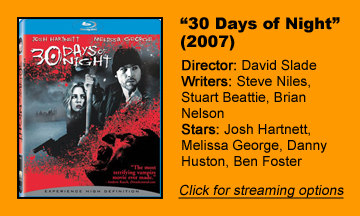I love adventures set in geographic extremes, and that’s the biggest appeal of “30 Days of Night” (2007), set in Barrow, Alaska. Odd places like this have me going to the internet, where I learned that Barrow has since been renamed Utqiagvik, and it actually experiences two straight months of night from mid-November to mid-January.
Inaccessible from other cities by road, the oil-industry-driven outpost has a population of over 4,000. But the film imagines a town of mere hundreds, only a few blocks wide.
Vampires use their heads
It’s big enough to attract vampires, who openly acknowledge they should’ve gone after populations in places without sunlight long ago. But it’s small enough to be filmed on what looks like one of those old Wild West sets (but covered in snow).
I assumed “30 Days” was filmed in the Vancouver area, but it was surprisingly shot in New Zealand.
Nonetheless, it broadly captures the isolation of Barrow, with some stylized elements such as a forbidding smoky sky when the vampires set oil afire, and some real-world elements such as the houses on stilts (albeit stubby stilts, not the tall ones you’ll see on the USA’s hurricane-prone Southeast coast).
Director David Slade’s film is well-lit, and this isn’t a flaw. Streetlights – even sparse and dim ones – reflecting off snow can provide a lot of illumination.
Painting the town red
Before the vampires take over the town, comic creator Steve Niles and his two co-writers build up both suspense and a sense of what people do in Barrow – including a mass exodus by airplane before the 30-day sunless period — although I would’ve liked more specifically localized people and professions.
Sheriff Eben Oleson (“The Faculty’s” Josh Hartnett) and wife Stella (Melissa George) could live anywhere; they are like the couple in “The Abyss” – estranged for vague reasons but still in love. Mark Boone Junior’s Beau lives in Barrow for the sake of freedom, and is miffed when Eben gives him a trivial motoring ticket; but Eben points out to deputy Billy (Manu Bennett) that it’ll make Beau feel more like part of the town.
“30 Days” could use more Inuit representation, considering the real-world population and the fact that the story is about loners and people of different lifestyles coming together. It only has one character who appears to be Native Alaskan.
Need for speed
The big stylistic takeaway is that the vampires – led by Danny Huston as Marlow – move in that way where the film is sped up. It’s a cliché now but was fresher in the Aughts, as these vampires join “28 Days Later’s” zombies with a need for speed – but only when attacking.
Marlow and his charges spend a lot of time skulking around with blood-covered chins and talking in an ancient language.
Armed only with my knowledge of the “X-Files”/ “30 Days” crossover comics, I can tell that the film captures the vibe of the source material. But it’s both slowly paced and choppily presented, and I didn’t totally get into the spirit of it. I think it’s a case of an efficient budget more so than editing mistakes, but many key moments are not shown to us.

For example, a major character from the buildup phase is taken by the vampires but that’s the last we see of her. Later, Billy goes through the most horrific incident – the same situation that serves as the twist climax of another 2007 horror film – and it happens entirely off screen.
Because of this corner-cutting, most of the attempts at digging into the peoples’ emotions in this month of fearful darkness fall flat.
Maybe the slow build promises too much, but the vampires aren’t as scary as they could be, nor is the presentation of the action memorable (aside from that sped-up-film trick); it’s merely competent and clear.
I won’t fight anyone if the style of “30 Days of Night” makes it one of their favorite horror flicks, but it didn’t suck me in. Still, the premise is great, the acting is solid, it has a lot of style (which seems to respect the comic), and it gives enough of the flavor of living at the top of the world to inspire further research.


